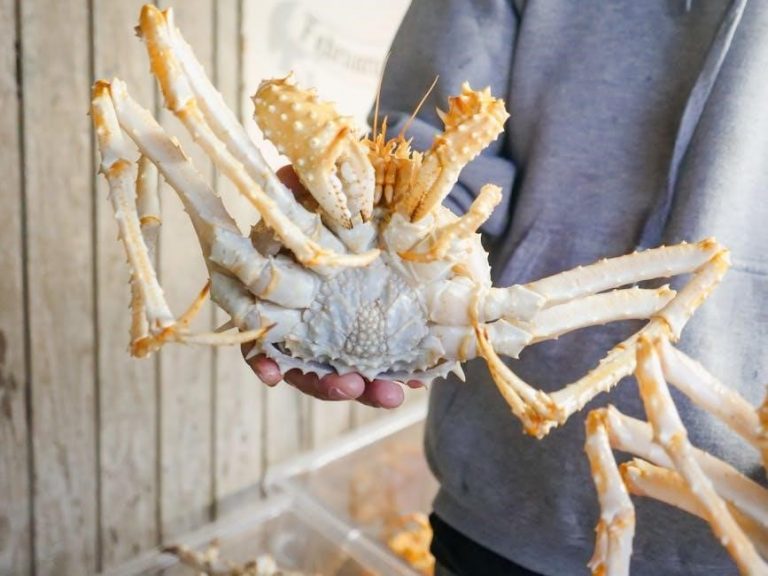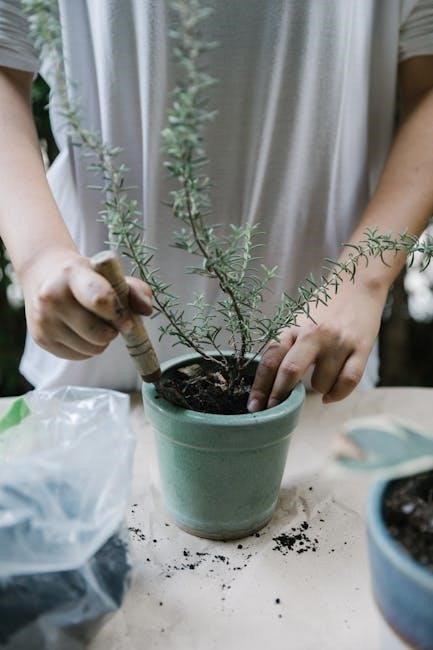
Air plants, or Tillandsia, are epiphytes needing no soil, thriving on air, water, and light. Their unique adaptations make them low-maintenance, ideal for indoor spaces. Proper care ensures vibrant growth and color.
1.1 What Are Air Plants?
Air plants, also known as Tillandsia, are epiphytes that grow without soil, absorbing moisture and nutrients through their leaves. Native to tropical climates, they thrive in environments with high humidity and bright, filtered light. These unique plants are popular for their low-maintenance care and ability to grow on various surfaces. With over 600 species, air plants vary in size, color, and texture, making them a fascinating addition to indoor spaces. Their adaptability and striking appearance have made them a favorite among plant enthusiasts.
1.2 Why Air Plants Are Unique
Air plants are unique because they don’t require soil to grow, absorbing moisture and nutrients through their leaves. Their epiphytic nature allows them to thrive on surfaces like rocks or branches. Unlike traditional plants, they survive without direct soil contact, making them ideal for decorative arrangements. Their ability to adapt to various environments and their striking appearance has made them popular for indoor spaces. This unique trait sets them apart from other plants, offering a low-maintenance yet visually captivating option for plant enthusiasts.
1.3 Basic Care Requirements
Air plants require consistent care to thrive. Provide bright, indirect light, avoiding direct sun. Water thoroughly 2-3 times a week, soaking the plant until water runs off. Ensure moderate humidity and good air circulation to prevent rot. Maintain temperatures between 50-90°F (10-32°C). Fertilize sparingly during the growing season with a water-soluble fertilizer at half strength. Avoid overwatering and ensure plants dry within a few hours to prevent root rot. Proper care ensures vibrant growth and long-lasting blooms.
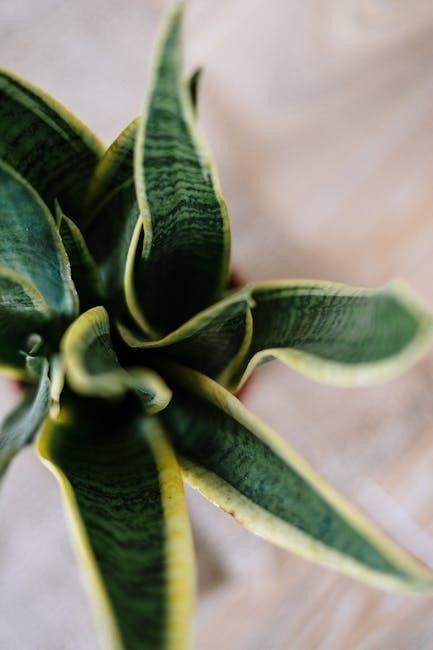
Lighting Requirements for Air Plants
Air plants thrive in bright, indirect light but avoid direct sunlight. East- or west-facing windows are ideal. Low light can lead to weak growth and no blooming.
2.1 Types of Light Air Plants Prefer
Air plants prefer bright, indirect light for optimal growth. Direct sunlight can cause leaves to become scorched, while low light may result in weak growth. Filtered or diffused light, such as through sheer curtains, is ideal. Some species can tolerate short periods of direct sun, but prolonged exposure should be avoided. Placing air plants near east- or west-facing windows ensures consistent, gentle illumination, promoting healthy growth and vibrant color displays.
2.2 How Much Light Is Needed
Air plants require consistent light exposure, typically 12-14 hours daily. Bright, indirect light is ideal, but avoid direct sun, which can scorch leaves. In low-light conditions, growth slows, and plants may lack color. Morning sun is beneficial, while afternoon sun should be filtered. For indoor spaces without natural light, high-quality grow lights can supplement, ensuring plants receive adequate illumination for photosynthesis and health. Proper light balance is crucial for their unique, soil-free survival and aesthetic appeal.
2.3 Best Placement in Your Home
Place air plants in areas with bright, indirect light, such as east- or west-facing windowsills. Avoid direct sunlight, especially during peak hours, to prevent scorching. Ideal spots include shelves or shelve near filtered sunlight sources. For spaces without natural light, use grow lights to provide sufficient illumination. Keep plants away from shaded areas, as low light can hinder growth. Ensure good air circulation and maintain consistent humidity. Avoid placing near heating vents or drafty areas to preserve optimal conditions for your air plants’ health and vitality.

Watering Your Air Plant
Water your air plant by fully submerging it in water for 1-3 hours, 1-3 times a week. Use filtered or rainwater; avoid distilled. Allow to dry within 4 hours to prevent rot.
3.1 Frequency of Watering
The frequency of watering your air plant depends on its environment. In humid, cool spaces, water once a week by submerging for 1-2 hours. In hot, dry conditions, increase to 2-3 times weekly. Ensure the plant dries within 4 hours to prevent root rot. Overwatering is a common mistake, so monitor your plant’s condition and adjust accordingly. Proper hydration keeps your air plant healthy and vibrant.
3.2 Optimal Watering Methods
For optimal watering, submerge your air plant in a bowl of room-temperature water for 1-2 hours. Alternatively, mist the plant thoroughly with a spray bottle. Ensure the entire surface is wet, allowing water to run off. After watering, gently shake excess moisture and place the plant upside down to dry. Use filtered or rainwater to avoid mineral buildup from tap water. Proper drying within 4 hours prevents root rot, ensuring your air plant stays healthy and thrives.
3.3 Drying Time After Watering
After watering, air plants need ample time to dry completely to prevent rot. Shake off excess water gently and place the plant upside down to ensure all moisture drains. Ideal drying time is 1-3 hours. Proper air circulation is crucial during this period. Avoid placing the plant in a closed container or humid environment until it’s fully dry. Ensuring your air plant dries thoroughly after watering is essential for maintaining its health and preventing root rot.
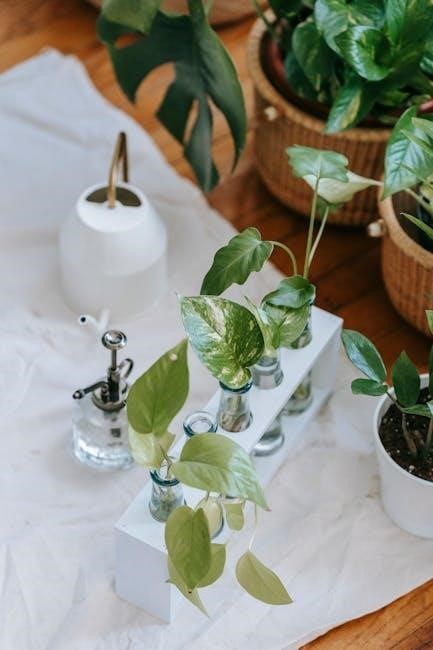
Humidity and Air Circulation
Air plants thrive in moderate humidity and require good air circulation to prevent rot. Keep them in well-ventilated areas, ideally 40-50% humidity, mimicking their natural habitats.
4.1 Maintaining Proper Humidity
Maintaining 40-50% humidity is essential for air plants. To achieve this, you can place the plant on a tray with water and pebbles or use a humidifier. Avoid distilled or softened water, as it can harm the plant. In drier environments, misting with filtered water 2-3 times a week helps sustain moisture levels. Proper humidity ensures the plant absorbs nutrients effectively and prevents dehydration.
4.2 Importance of Air Circulation
Air circulation is crucial for air plants as it prevents water accumulation and root rot. Place plants near windows or fans to enhance airflow. Proper circulation ensures leaves dry fully, avoiding rot. Without adequate air movement, plants may develop root rot and stunted growth. Ensuring good air circulation promotes healthy growth and prevents common issues, mirroring their natural habitats.

Fertilization Tips
Use water-soluble fertilizers like Grow More Bromeliad Tillandsia at 1/4 strength. Fertilize once a month, adjusting based on environmental conditions for optimal growth and bloom color.
5.1 Best Fertilizers for Air Plants
Use water-soluble fertilizers like Grow More Bromeliad Tillandsia or fish-based options at 1/4 the recommended strength. Avoid urea-based products, as they are ineffective for air plants. Fertilize monthly, soaking the entire plant in a diluted solution. For optimal results, apply during watering sessions but avoid over-fertilizing, as this can cause damage. Always follow label instructions and adjust based on environmental conditions to ensure healthy growth and vibrant blooms.
5.2 How to Fertilize Correctly
Fertilize by soaking the entire air plant in a water-soluble fertilizer solution, such as Grow More Bromeliad Tillandsia, at 1/4 the recommended strength. Submerge the plant in the solution for 1-2 hours during its weekly watering session. Avoid spraying fertilizer directly on the leaves, as this can cause damage. Instead, ensure the entire plant absorbs the nutrients through its leaves and roots. Always follow the product’s instructions and adjust based on the plant’s response to prevent over-fertilization, which can harm the plant.
5.3 Frequency of Feeding
Fertilize your air plants once a month during the growing season (spring-fall) to promote healthy growth and blooming. Use a water-soluble fertilizer at 1/4 the recommended strength. Apply by soaking the entire plant in the solution for 1-2 hours. Avoid fertilizing during the winter months when plants are dormant. Over-fertilization can harm the plants, so always follow the product’s instructions. This balanced feeding schedule ensures your air plants receive the necessary nutrients without stress, keeping them vibrant and thriving year-round.
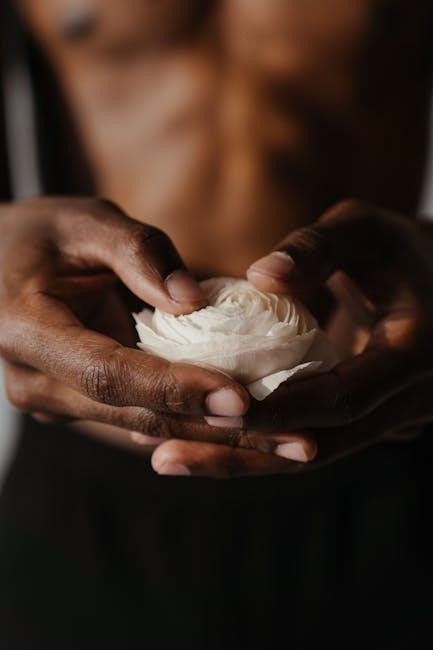
Temperature Requirements
Air plants thrive in temperatures between 50°F and 90°F (10°C and 32°C). Avoid extreme heat or cold to prevent damage. Optimal growth occurs in moderate, stable conditions, ensuring the plant’s ability to absorb moisture and nutrients effectively. Protect from frost and prolonged exposure to temperatures above 100°F (38°C). Maintain consistent indoor temperatures for best results, as fluctuating conditions can stress the plant and hinder its health.
6.1 Ideal Temperature Range
Air plants thrive in temperatures between 50°F and 90°F (10°C and 32°C). This range supports healthy growth and prevents stress. Daytime temperatures around 75°F to 85°F (24°C to 29°C) are ideal, while nighttime temperatures can dip slightly lower. Avoid placing air plants near heating vents, radiators, or drafty windows to maintain stable conditions. Extreme temperatures, below 40°F (4°C) or above 100°F (38°C), can cause damage or kill the plant. Consistent, moderate indoor temperatures ensure optimal health and vitality.
6.2 Avoiding Extreme Temperatures
Avoid exposing air plants to temperatures below 40°F (4°C) or above 100°F (38°C), as this can cause irreversible damage; Sudden drops or spikes stress the plant, leading to wilted leaves or death. Keep air plants away from heating vents, fireplaces, and drafty windows during winter. Similarly, avoid placing them near air conditioning units or direct sunlight in summer. Maintaining a stable indoor environment ensures your air plant remains healthy and thrives year-round.

Propagation of Air Plants
Air plants propagate by producing offsets, or “pups,” around the base of the mother plant. This natural process occurs as the plant matures and blooms.
Allow the plant to flower, then wait for pups to grow. Once pups are one-third the size of the parent, gently separate and care for them as new plants.
7.1 How Air Plants Reproduce
Air plants reproduce primarily through offsets or “pups,” which develop around the mother plant’s base after blooming. This asexual method ensures genetic continuity. Additionally, they produce flowers and seeds, enabling sexual reproduction. Pollinators aid in seed production, which can lead to new plants. Thus, air plants utilize both methods for effective propagation and environmental adaptation.
7.2 Steps to Successfully Propagate
To propagate air plants, allow the mother plant to bloom, as this encourages pup growth. Once pups reach one-third the mother’s size, gently twist or cut them off. Let the separated pups dry for 24-48 hours to prevent rot. Place them in bright, indirect light and water as you would the mother plant. Fertilize sparingly with a water-soluble solution. With proper care, new plants will thrive, continuing the cycle. Patience is key, as propagation is a natural process.
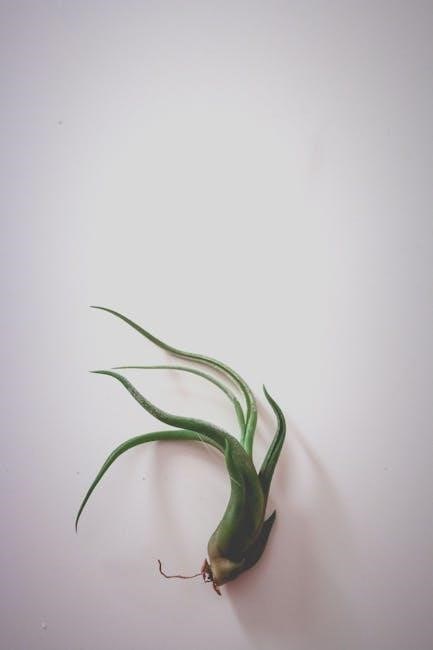
Common Mistakes to Avoid
Overwatering, underwatering, and poor lighting are frequent errors. Ensure proper watering balance, avoid direct sun, and provide consistent indirect light for optimal health and growth.
8.1 Overwatering
Overwatering is a common mistake that can lead to root rot and plant death. Air plants thrive when watered correctly, but excessive moisture can trap water in foliage, causing decay. Ensure plants dry completely after watering. Avoid soaking for too long or too frequently, especially in humid environments. Proper drainage and air circulation are crucial to prevent waterlogged roots. Always shake off excess water and allow plants to drip dry upside down to maintain health and prevent rot.
8.2 Underwatering
Underwatering can cause air plants to become brittle, wilted, or discolored, with tips turning brown. Insufficient moisture disrupts their ability to absorb nutrients. Check plants weekly; if leaves feel dry, increase watering frequency. In humid environments, reduce watering, while in dry climates, water more often. Use room-temperature water, avoiding distilled or softened varieties. Ensure plants are hydrated adequately, especially during hot seasons, to maintain their health and vibrant appearance. Adjust watering schedules based on environmental conditions to prevent underwatering issues.
8.3 Poor Lighting Conditions
Air plants thrive in bright, indirect light but suffer in low-light environments or direct sunlight. Insufficient light leads to weak, discolored leaves, while direct sun causes bleaching. Place plants near east- or west-facing windows for optimal light. Avoid full summer sun, as it can damage leaves. Ensure consistent lighting to promote healthy growth and vibrant colors. Proper lighting balance is essential for maintaining their unique appearance and vitality. Monitor light exposure to prevent these common issues and ensure your air plants flourish.

Troubleshooting Air Plant Issues
Air plants may develop brown leaves or droop due to underwatering or overwatering. Adjust watering frequency and ensure proper air circulation to restore health and vitality.
9.1 Signs of Unhealthy Plants
Unhealthy air plants often show brown or crispy leaves, indicating underwatering. Overwatering leads to soft, mushy bases and root rot. Discoloration or droopy foliage may signal nutrient deficiencies or pests. If left unchecked, these issues can stunt growth or cause plant death. Regular monitoring helps catch problems early, ensuring timely solutions for optimal health.
9.2 Solutions for Common Problems
For overwatering, reduce frequency and ensure proper drying. Underwatering can be fixed by increasing soak time. Fertilize with a water-soluble solution at 1/4 strength. Prune dead leaves to prevent rot. Improve air circulation to avoid moisture buildup. Treat pests with mild insecticides if necessary. Adjust lighting to avoid direct sun, which can cause discoloration. Regular monitoring and timely adjustments help restore plant health and prevent further issues.
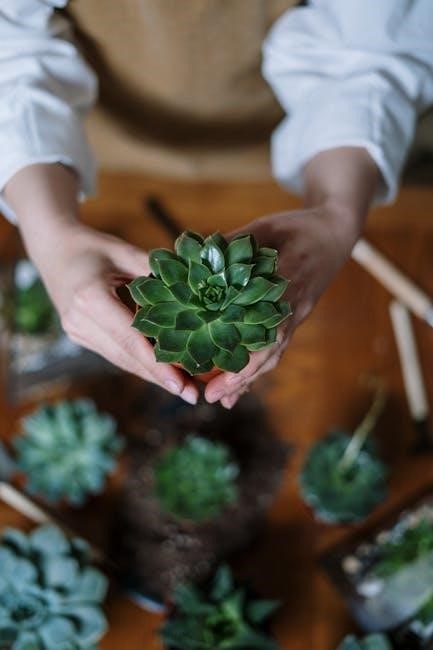
Additional Tips for Optimal Care
Regularly inspect for pests and gently clean leaves with a soft brush. Rotate plants for even growth and exposure to light. Maintain consistent care routines for thriving plants.
10.1 Rotation for Even Growth
Rotating air plants ensures balanced growth and prevents uneven development. Gently turn plants weekly to expose all sides to light, promoting symmetrical shape and vibrant color. This method mimics natural conditions, aiding in uniform blooming and leaf development. Regular rotation also helps maintain structural integrity, keeping your Tillandsia visually appealing and healthy. Over time, this practice enhances their natural beauty and longevity.
10.2 Cleaning the Plants
Cleaning air plants is essential for their health. Gently remove debris or dust from leaves using a soft brush or a damp cloth. Avoid harsh chemicals, as they can damage the plant. After watering, lightly shake the plant to eliminate excess moisture, preventing rot. Regular cleaning ensures proper air circulation and light absorption, promoting healthy growth. This simple practice helps maintain the plant’s natural beauty and prevents potential issues like fungal growth or pest infestations.
10.3 Monitoring for Pests
Regularly inspect your air plants for pests like mealybugs, spider mites, or scale. Look for white, cottony patches or fine webs. If infested, gently rinse the plant with water or use insecticidal soap, following label instructions. Avoid harsh pesticides, as they can harm the plant. Early detection and treatment prevent severe damage. Maintain good air circulation and hygiene to discourage pests, ensuring your air plants remain healthy and thriving. Consistent monitoring is key to protecting your plants from unwanted invaders.



